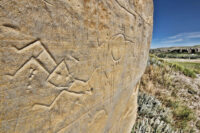Baptism of fire for new recruits
By Lethbridge Herald on October 19, 2020.
 New Lethbridge Fire and EMS recruits take part in training held Monday at the Fire Station No. 4 training grounds. Recruits are almost ready to hit the streets to respond to fires, but training had to be done slightly differently this year due to COVID-19. Herald photo by Tim Kalinowski
New Lethbridge Fire and EMS recruits take part in training held Monday at the Fire Station No. 4 training grounds. Recruits are almost ready to hit the streets to respond to fires, but training had to be done slightly differently this year due to COVID-19. Herald photo by Tim KalinowskiTim Kalinowski
Lethbridge Herald
tkalinowski@lethbridgeherald.com
Lethbridge Fire and EMS is set to welcome 12 new recruits into full-time service in the coming weeks, and this year’s training, due to COVID-19, hasn’t quite been like a class like any other, said lead trainer Les Hilliard.
“We had to adapt and overcome,” he explained to reporters at a demonstration at the Fire Hall No. 4 training grounds on Monday. “At first we were very limited on how many people we could put together for training. Our ranks on the EMS side were being decimated through COVID isolations. No one did get COVID from our service yet, thank goodness, but we still had to isolate and follow the provincial guidelines.”
This essentially changed the usual order of the training, said Hilliard, with EMS training coming first and the fire training a bit truncated at the end. In fact, confirmed Hilliard, due to needs within the service, the new recruits had already been working with the ambulance on the streets for some time this year prior to starting their fire training. Because of the demands and pressures recruits faced this year, Hilliard has dubbed them the “COVID Bulldogs.”
“The way we did this shows that our recruit process works very well,” he said. “We are able to take people who have prior experience and put them onto the street, and they adapt very well to our system we have here. I would like to have had more time training the fire side, but due to the efforts of these individuals, who are strong candidates, I think they will do very well.”
Recruit James Akerley, at 29, at least had a strong background in EMS to draw from prior to coming to Lethbridge. He has worked as a professional paramedic since 2012.
“I have been EMS since 2012, but I have always wanted to come down to Lethbridge because of the integration,” he explained. “I have always wanted to have both the fire side and the EMS side, and have them work together for the rest of my career.”
Akerley acknowledged nothing in his prior experience had prepared him for the rigours of fire training, though.
“Fire training is a lot more physically demanding, and there is more science than I expected behind what we do on the fire aspect,” he admitted. “Reading smoke. Reading fire flow paths and whatnot. It’s a lot different, for sure.
Follow @TimKalHerald on Twitter
-1




